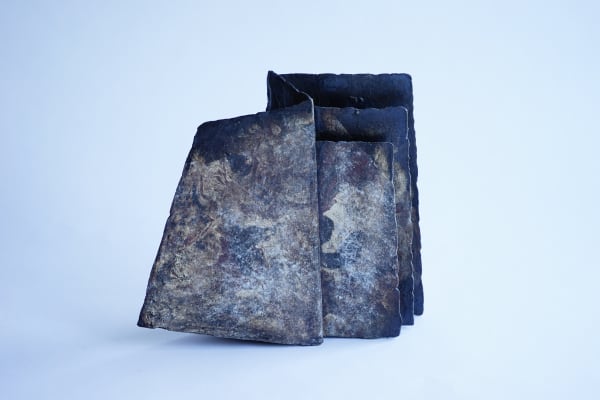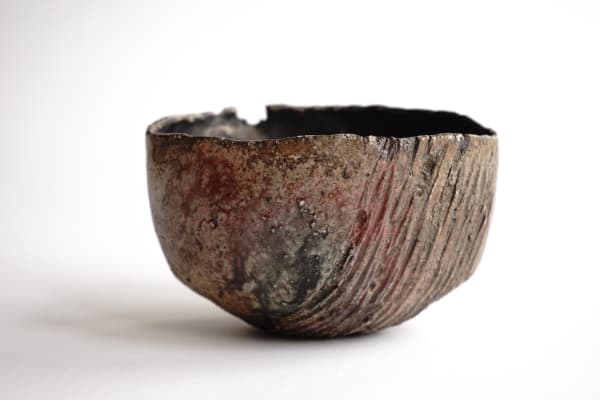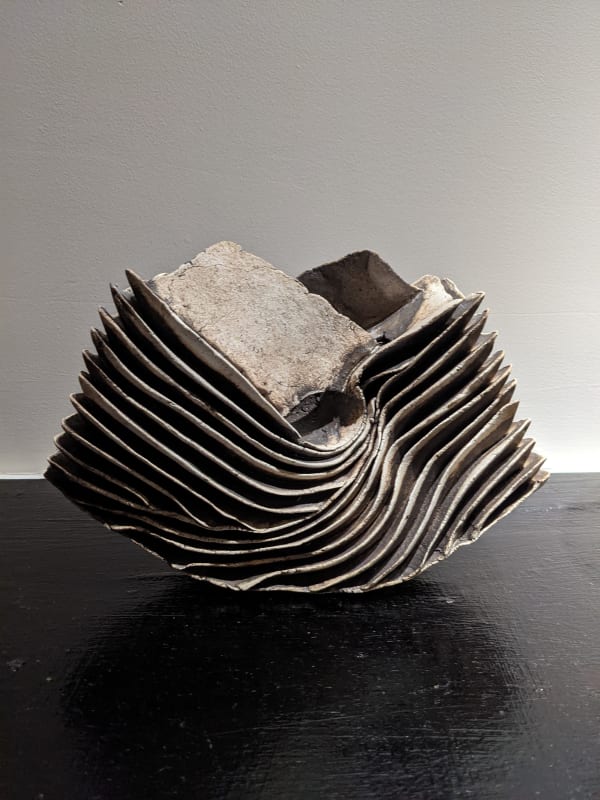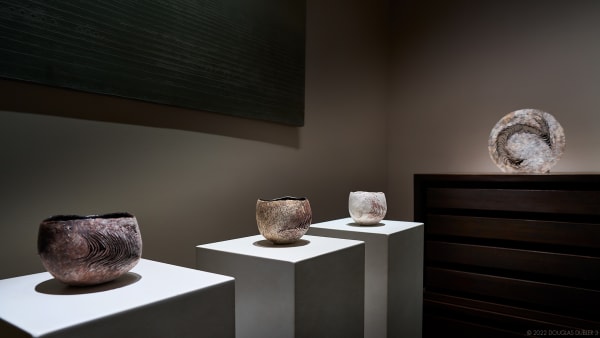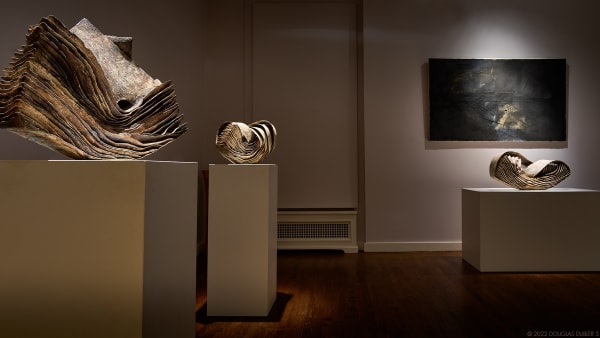
"When I decide to express something through clay, I look for my answer in its roughness or fragility, its ephemerality, and its tension or lightness." – Yukiya Izumita
Precious Layers
Shoko Aono
What is it that Yukiya Izumita tries to create with clay?
Through the lamination of numerous layers, resembling burnt newspaper, Izumita creates fantastic figures. Their texture is like rusted iron, conjuring images of ancient, petrified wood. While difficult to comprehend, these forms warm our hearts, and if we look at them closely, they appear to emit pleasant, silent vibrations that then start to expand. They encompass gravity and weightlessness, balance and imbalance, strength and weakness, void and solidity, but above all; they embody Izumita's experiments in discovering the connection between himself and the world.
'I exist through my connection with the clay,' he says. 'When I concentrate on this connection, I become free. When I confront the clay, everything is in a state of chaos, but as I discover a good rhythm between myself and the clay, new works are born. My work consists of becoming aware of this rhythm.'
For Izumita, pottery comprises a physical dialogue between the material of the clay and the attraction he feels towards the scenery he wants to see. How can harmony be found within friction? How can ethereality be found within the heavy clay? How can darkness be turned into light? The genesis of Izumita's work may be said to be human love.
His first exhibition in New York was held in 2013, after the Great Eastern Japan Earthquake/Tsunami, and his works possessed the earth's heat. This, his fourth exhibition, displays the wisdom that has resulted from facing the pandemic. The pieces seem to indicate the courage that comes of surmounting loads too great to bear and discovering the beauty within chaos. We hope this exhibition can be a celebration: not only of Izumita's works but of the valiant efforts of everybody living today to overcome tragedy and triumph.
- X
- Tumblr
-
 Yukiya IzumitaSekisoh 積層裂, 2020Ceramic%3Cdiv%20class%3D%22artist%22%3EYukiya%20Izumita%3C/div%3E%3Cdiv%20class%3D%22title_and_year%22%3E%3Cspan%20class%3D%22title_and_year_title%22%3ESekisoh%20%E7%A9%8D%E5%B1%A4%E8%A3%82%3C/span%3E%3Cspan%20class%3D%22comma%22%3E%2C%20%3C/span%3E%3Cspan%20class%3D%22title_and_year_year%22%3E2020%3C/span%3E%3C/div%3E%3Cdiv%20class%3D%22medium%22%3ECeramic%3C/div%3E
Yukiya IzumitaSekisoh 積層裂, 2020Ceramic%3Cdiv%20class%3D%22artist%22%3EYukiya%20Izumita%3C/div%3E%3Cdiv%20class%3D%22title_and_year%22%3E%3Cspan%20class%3D%22title_and_year_title%22%3ESekisoh%20%E7%A9%8D%E5%B1%A4%E8%A3%82%3C/span%3E%3Cspan%20class%3D%22comma%22%3E%2C%20%3C/span%3E%3Cspan%20class%3D%22title_and_year_year%22%3E2020%3C/span%3E%3C/div%3E%3Cdiv%20class%3D%22medium%22%3ECeramic%3C/div%3E
-
 Yukiya Izumita, Sekisoh, 2021%3Cspan%20class%3D%22artist%22%3E%3Cstrong%3EYukiya%20Izumita%3C/strong%3E%3C/span%3E%3Cspan%20class%3D%22comma%22%3E%2C%20%3C/span%3E%3Cspan%20class%3D%22title%22%3E%3Cem%3ESekisoh%3C/em%3E%3Cspan%20class%3D%22comma%22%3E%2C%20%3C/span%3E2021%3C/span%3E
Yukiya Izumita, Sekisoh, 2021%3Cspan%20class%3D%22artist%22%3E%3Cstrong%3EYukiya%20Izumita%3C/strong%3E%3C/span%3E%3Cspan%20class%3D%22comma%22%3E%2C%20%3C/span%3E%3Cspan%20class%3D%22title%22%3E%3Cem%3ESekisoh%3C/em%3E%3Cspan%20class%3D%22comma%22%3E%2C%20%3C/span%3E2021%3C/span%3E
-
 Yukiya Izumita, Sekisoh vase, 2021%3Cspan%20class%3D%22artist%22%3E%3Cstrong%3EYukiya%20Izumita%3C/strong%3E%3C/span%3E%3Cspan%20class%3D%22comma%22%3E%2C%20%3C/span%3E%3Cspan%20class%3D%22title%22%3E%3Cem%3ESekisoh%20vase%3C/em%3E%3Cspan%20class%3D%22comma%22%3E%2C%20%3C/span%3E2021%3C/span%3E
Yukiya Izumita, Sekisoh vase, 2021%3Cspan%20class%3D%22artist%22%3E%3Cstrong%3EYukiya%20Izumita%3C/strong%3E%3C/span%3E%3Cspan%20class%3D%22comma%22%3E%2C%20%3C/span%3E%3Cspan%20class%3D%22title%22%3E%3Cem%3ESekisoh%20vase%3C/em%3E%3Cspan%20class%3D%22comma%22%3E%2C%20%3C/span%3E2021%3C/span%3E
-
 Yukiya Izumita, Sekisoh vase, 2021%3Cspan%20class%3D%22artist%22%3E%3Cstrong%3EYukiya%20Izumita%3C/strong%3E%3C/span%3E%3Cspan%20class%3D%22comma%22%3E%2C%20%3C/span%3E%3Cspan%20class%3D%22title%22%3E%3Cem%3ESekisoh%20vase%3C/em%3E%3Cspan%20class%3D%22comma%22%3E%2C%20%3C/span%3E2021%3C/span%3E
Yukiya Izumita, Sekisoh vase, 2021%3Cspan%20class%3D%22artist%22%3E%3Cstrong%3EYukiya%20Izumita%3C/strong%3E%3C/span%3E%3Cspan%20class%3D%22comma%22%3E%2C%20%3C/span%3E%3Cspan%20class%3D%22title%22%3E%3Cem%3ESekisoh%20vase%3C/em%3E%3Cspan%20class%3D%22comma%22%3E%2C%20%3C/span%3E2021%3C/span%3E
-
 Yukiya Izumita, Sekisoh, 2021Yukiya%20Izumita%3Cspan%20class%3D%22comma%22%3E%2C%20%3C/span%3ESekisoh%3Cspan%20class%3D%22comma%22%3E%2C%20%3C/span%3E2021
Yukiya Izumita, Sekisoh, 2021Yukiya%20Izumita%3Cspan%20class%3D%22comma%22%3E%2C%20%3C/span%3ESekisoh%3Cspan%20class%3D%22comma%22%3E%2C%20%3C/span%3E2021
-
 Yukiya Izumita, Sekisoh vase, 2021%3Cspan%20class%3D%22artist%22%3E%3Cstrong%3EYukiya%20Izumita%3C/strong%3E%3C/span%3E%3Cspan%20class%3D%22comma%22%3E%2C%20%3C/span%3E%3Cspan%20class%3D%22title%22%3E%3Cem%3ESekisoh%20vase%3C/em%3E%3Cspan%20class%3D%22comma%22%3E%2C%20%3C/span%3E2021%3C/span%3E
Yukiya Izumita, Sekisoh vase, 2021%3Cspan%20class%3D%22artist%22%3E%3Cstrong%3EYukiya%20Izumita%3C/strong%3E%3C/span%3E%3Cspan%20class%3D%22comma%22%3E%2C%20%3C/span%3E%3Cspan%20class%3D%22title%22%3E%3Cem%3ESekisoh%20vase%3C/em%3E%3Cspan%20class%3D%22comma%22%3E%2C%20%3C/span%3E2021%3C/span%3E
-
 Yukiya Izumita, Sekisoh tea bowl, 2021%3Cspan%20class%3D%22artist%22%3E%3Cstrong%3EYukiya%20Izumita%3C/strong%3E%3C/span%3E%3Cspan%20class%3D%22comma%22%3E%2C%20%3C/span%3E%3Cspan%20class%3D%22title%22%3E%3Cem%3ESekisoh%20tea%20bowl%3C/em%3E%3Cspan%20class%3D%22comma%22%3E%2C%20%3C/span%3E2021%3C/span%3E
Yukiya Izumita, Sekisoh tea bowl, 2021%3Cspan%20class%3D%22artist%22%3E%3Cstrong%3EYukiya%20Izumita%3C/strong%3E%3C/span%3E%3Cspan%20class%3D%22comma%22%3E%2C%20%3C/span%3E%3Cspan%20class%3D%22title%22%3E%3Cem%3ESekisoh%20tea%20bowl%3C/em%3E%3Cspan%20class%3D%22comma%22%3E%2C%20%3C/span%3E2021%3C/span%3E
-
 Yukiya Izumita, Crack tea bowl, 2021%3Cspan%20class%3D%22artist%22%3E%3Cstrong%3EYukiya%20Izumita%3C/strong%3E%3C/span%3E%3Cspan%20class%3D%22comma%22%3E%2C%20%3C/span%3E%3Cspan%20class%3D%22title%22%3E%3Cem%3ECrack%20tea%20bowl%3C/em%3E%3Cspan%20class%3D%22comma%22%3E%2C%20%3C/span%3E2021%3C/span%3E
Yukiya Izumita, Crack tea bowl, 2021%3Cspan%20class%3D%22artist%22%3E%3Cstrong%3EYukiya%20Izumita%3C/strong%3E%3C/span%3E%3Cspan%20class%3D%22comma%22%3E%2C%20%3C/span%3E%3Cspan%20class%3D%22title%22%3E%3Cem%3ECrack%20tea%20bowl%3C/em%3E%3Cspan%20class%3D%22comma%22%3E%2C%20%3C/span%3E2021%3C/span%3E
-
 Yukiya Izumita, Geometric vase, 2021%3Cspan%20class%3D%22artist%22%3E%3Cstrong%3EYukiya%20Izumita%3C/strong%3E%3C/span%3E%3Cspan%20class%3D%22comma%22%3E%2C%20%3C/span%3E%3Cspan%20class%3D%22title%22%3E%3Cem%3EGeometric%20vase%3C/em%3E%3Cspan%20class%3D%22comma%22%3E%2C%20%3C/span%3E2021%3C/span%3E
Yukiya Izumita, Geometric vase, 2021%3Cspan%20class%3D%22artist%22%3E%3Cstrong%3EYukiya%20Izumita%3C/strong%3E%3C/span%3E%3Cspan%20class%3D%22comma%22%3E%2C%20%3C/span%3E%3Cspan%20class%3D%22title%22%3E%3Cem%3EGeometric%20vase%3C/em%3E%3Cspan%20class%3D%22comma%22%3E%2C%20%3C/span%3E2021%3C/span%3E
-
 Yukiya Izumita, Sekisoh object, 2021%3Cspan%20class%3D%22artist%22%3E%3Cstrong%3EYukiya%20Izumita%3C/strong%3E%3C/span%3E%3Cspan%20class%3D%22comma%22%3E%2C%20%3C/span%3E%3Cspan%20class%3D%22title%22%3E%3Cem%3ESekisoh%20object%3C/em%3E%3Cspan%20class%3D%22comma%22%3E%2C%20%3C/span%3E2021%3C/span%3E
Yukiya Izumita, Sekisoh object, 2021%3Cspan%20class%3D%22artist%22%3E%3Cstrong%3EYukiya%20Izumita%3C/strong%3E%3C/span%3E%3Cspan%20class%3D%22comma%22%3E%2C%20%3C/span%3E%3Cspan%20class%3D%22title%22%3E%3Cem%3ESekisoh%20object%3C/em%3E%3Cspan%20class%3D%22comma%22%3E%2C%20%3C/span%3E2021%3C/span%3E
-
 Yukiya Izumita, Lidded Sekisoh, 2021%3Cspan%20class%3D%22artist%22%3E%3Cstrong%3EYukiya%20Izumita%3C/strong%3E%3C/span%3E%3Cspan%20class%3D%22comma%22%3E%2C%20%3C/span%3E%3Cspan%20class%3D%22title%22%3E%3Cem%3ELidded%20Sekisoh%3C/em%3E%3Cspan%20class%3D%22comma%22%3E%2C%20%3C/span%3E2021%3C/span%3E
Yukiya Izumita, Lidded Sekisoh, 2021%3Cspan%20class%3D%22artist%22%3E%3Cstrong%3EYukiya%20Izumita%3C/strong%3E%3C/span%3E%3Cspan%20class%3D%22comma%22%3E%2C%20%3C/span%3E%3Cspan%20class%3D%22title%22%3E%3Cem%3ELidded%20Sekisoh%3C/em%3E%3Cspan%20class%3D%22comma%22%3E%2C%20%3C/span%3E2021%3C/span%3E
-
 Yukiya Izumita, Sekisoh, 2021%3Cspan%20class%3D%22artist%22%3E%3Cstrong%3EYukiya%20Izumita%3C/strong%3E%3C/span%3E%3Cspan%20class%3D%22comma%22%3E%2C%20%3C/span%3E%3Cspan%20class%3D%22title%22%3E%3Cem%3ESekisoh%3C/em%3E%3Cspan%20class%3D%22comma%22%3E%2C%20%3C/span%3E2021%3C/span%3E
Yukiya Izumita, Sekisoh, 2021%3Cspan%20class%3D%22artist%22%3E%3Cstrong%3EYukiya%20Izumita%3C/strong%3E%3C/span%3E%3Cspan%20class%3D%22comma%22%3E%2C%20%3C/span%3E%3Cspan%20class%3D%22title%22%3E%3Cem%3ESekisoh%3C/em%3E%3Cspan%20class%3D%22comma%22%3E%2C%20%3C/span%3E2021%3C/span%3E
-
 Yukiya Izumita, Lidded Sekisoh, 2021Yukiya%20Izumita%3Cspan%20class%3D%22comma%22%3E%2C%20%3C/span%3ELidded%20Sekisoh%3Cspan%20class%3D%22comma%22%3E%2C%20%3C/span%3E2021
Yukiya Izumita, Lidded Sekisoh, 2021Yukiya%20Izumita%3Cspan%20class%3D%22comma%22%3E%2C%20%3C/span%3ELidded%20Sekisoh%3Cspan%20class%3D%22comma%22%3E%2C%20%3C/span%3E2021
-
 Yukiya Izumita, Lidded Sekisoh, 2021Yukiya%20Izumita%3Cspan%20class%3D%22comma%22%3E%2C%20%3C/span%3ELidded%20Sekisoh%3Cspan%20class%3D%22comma%22%3E%2C%20%3C/span%3E2021
Yukiya Izumita, Lidded Sekisoh, 2021Yukiya%20Izumita%3Cspan%20class%3D%22comma%22%3E%2C%20%3C/span%3ELidded%20Sekisoh%3Cspan%20class%3D%22comma%22%3E%2C%20%3C/span%3E2021
-
 Yukiya Izumita, Sekisoh tea bowl, 2021Yukiya%20Izumita%3Cspan%20class%3D%22comma%22%3E%2C%20%3C/span%3ESekisoh%20tea%20bowl%3Cspan%20class%3D%22comma%22%3E%2C%20%3C/span%3E2021
Yukiya Izumita, Sekisoh tea bowl, 2021Yukiya%20Izumita%3Cspan%20class%3D%22comma%22%3E%2C%20%3C/span%3ESekisoh%20tea%20bowl%3Cspan%20class%3D%22comma%22%3E%2C%20%3C/span%3E2021
-
 Yukiya Izumita, Sekisoh tea bowl, 2021Yukiya%20Izumita%3Cspan%20class%3D%22comma%22%3E%2C%20%3C/span%3ESekisoh%20tea%20bowl%3Cspan%20class%3D%22comma%22%3E%2C%20%3C/span%3E2021
Yukiya Izumita, Sekisoh tea bowl, 2021Yukiya%20Izumita%3Cspan%20class%3D%22comma%22%3E%2C%20%3C/span%3ESekisoh%20tea%20bowl%3Cspan%20class%3D%22comma%22%3E%2C%20%3C/span%3E2021
-
 Yukiya Izumita, Sekisoh, 2021Yukiya%20Izumita%3Cspan%20class%3D%22comma%22%3E%2C%20%3C/span%3ESekisoh%3Cspan%20class%3D%22comma%22%3E%2C%20%3C/span%3E2021
Yukiya Izumita, Sekisoh, 2021Yukiya%20Izumita%3Cspan%20class%3D%22comma%22%3E%2C%20%3C/span%3ESekisoh%3Cspan%20class%3D%22comma%22%3E%2C%20%3C/span%3E2021
-
 Yukiya Izumita, Crack tea bowl, 2021Yukiya%20Izumita%3Cspan%20class%3D%22comma%22%3E%2C%20%3C/span%3ECrack%20tea%20bowl%3Cspan%20class%3D%22comma%22%3E%2C%20%3C/span%3E2021
Yukiya Izumita, Crack tea bowl, 2021Yukiya%20Izumita%3Cspan%20class%3D%22comma%22%3E%2C%20%3C/span%3ECrack%20tea%20bowl%3Cspan%20class%3D%22comma%22%3E%2C%20%3C/span%3E2021
-
 Yukiya Izumita, Sekisoh vase , 2021Yukiya%20Izumita%3Cspan%20class%3D%22comma%22%3E%2C%20%3C/span%3ESekisoh%20vase%20%3Cspan%20class%3D%22comma%22%3E%2C%20%3C/span%3E2021
Yukiya Izumita, Sekisoh vase , 2021Yukiya%20Izumita%3Cspan%20class%3D%22comma%22%3E%2C%20%3C/span%3ESekisoh%20vase%20%3Cspan%20class%3D%22comma%22%3E%2C%20%3C/span%3E2021
-
 Yukiya Izumita, Sekisoh Incense Burner, 2021Yukiya%20Izumita%3Cspan%20class%3D%22comma%22%3E%2C%20%3C/span%3ESekisoh%20Incense%20Burner%3Cspan%20class%3D%22comma%22%3E%2C%20%3C/span%3E2021
Yukiya Izumita, Sekisoh Incense Burner, 2021Yukiya%20Izumita%3Cspan%20class%3D%22comma%22%3E%2C%20%3C/span%3ESekisoh%20Incense%20Burner%3Cspan%20class%3D%22comma%22%3E%2C%20%3C/span%3E2021
-
 Yukiya Izumita, (24) 積層フタモノ - Lidded Seksoh , 2021%3Cspan%20class%3D%22artist%22%3E%3Cstrong%3EYukiya%20Izumita%3C/strong%3E%3C/span%3E%3Cspan%20class%3D%22comma%22%3E%2C%20%3C/span%3E%3Cspan%20class%3D%22title%22%3E%3Cem%3E%2824%29%20%26%2331309%3B%26%2323652%3B%26%2312501%3B%26%2312479%3B%26%2312514%3B%26%2312494%3B%20-%20Lidded%20Seksoh%20%3C/em%3E%3Cspan%20class%3D%22comma%22%3E%2C%20%3C/span%3E2021%3C/span%3E
Yukiya Izumita, (24) 積層フタモノ - Lidded Seksoh , 2021%3Cspan%20class%3D%22artist%22%3E%3Cstrong%3EYukiya%20Izumita%3C/strong%3E%3C/span%3E%3Cspan%20class%3D%22comma%22%3E%2C%20%3C/span%3E%3Cspan%20class%3D%22title%22%3E%3Cem%3E%2824%29%20%26%2331309%3B%26%2323652%3B%26%2312501%3B%26%2312479%3B%26%2312514%3B%26%2312494%3B%20-%20Lidded%20Seksoh%20%3C/em%3E%3Cspan%20class%3D%22comma%22%3E%2C%20%3C/span%3E2021%3C/span%3E
-
 Yukiya Izumita, (23) 積層 環 - Sekisoh Ring, 2021%3Cspan%20class%3D%22artist%22%3E%3Cstrong%3EYukiya%20Izumita%3C/strong%3E%3C/span%3E%3Cspan%20class%3D%22comma%22%3E%2C%20%3C/span%3E%3Cspan%20class%3D%22title%22%3E%3Cem%3E%2823%29%20%26%2331309%3B%26%2323652%3B%20%26%2329872%3B%20-%20Sekisoh%20Ring%3C/em%3E%3Cspan%20class%3D%22comma%22%3E%2C%20%3C/span%3E2021%3C/span%3E
Yukiya Izumita, (23) 積層 環 - Sekisoh Ring, 2021%3Cspan%20class%3D%22artist%22%3E%3Cstrong%3EYukiya%20Izumita%3C/strong%3E%3C/span%3E%3Cspan%20class%3D%22comma%22%3E%2C%20%3C/span%3E%3Cspan%20class%3D%22title%22%3E%3Cem%3E%2823%29%20%26%2331309%3B%26%2323652%3B%20%26%2329872%3B%20-%20Sekisoh%20Ring%3C/em%3E%3Cspan%20class%3D%22comma%22%3E%2C%20%3C/span%3E2021%3C/span%3E
-
 Yukiya Izumita, (22) 積層 - Sekisoh, 2021%3Cspan%20class%3D%22artist%22%3E%3Cstrong%3EYukiya%20Izumita%3C/strong%3E%3C/span%3E%3Cspan%20class%3D%22comma%22%3E%2C%20%3C/span%3E%3Cspan%20class%3D%22title%22%3E%3Cem%3E%2822%29%20%26%2331309%3B%26%2323652%3B%20-%20Sekisoh%3C/em%3E%3Cspan%20class%3D%22comma%22%3E%2C%20%3C/span%3E2021%3C/span%3E
Yukiya Izumita, (22) 積層 - Sekisoh, 2021%3Cspan%20class%3D%22artist%22%3E%3Cstrong%3EYukiya%20Izumita%3C/strong%3E%3C/span%3E%3Cspan%20class%3D%22comma%22%3E%2C%20%3C/span%3E%3Cspan%20class%3D%22title%22%3E%3Cem%3E%2822%29%20%26%2331309%3B%26%2323652%3B%20-%20Sekisoh%3C/em%3E%3Cspan%20class%3D%22comma%22%3E%2C%20%3C/span%3E2021%3C/span%3E
-
 Yukiya Izumita, Sekisoh object , 2021%3Cspan%20class%3D%22artist%22%3E%3Cstrong%3EYukiya%20Izumita%3C/strong%3E%3C/span%3E%3Cspan%20class%3D%22comma%22%3E%2C%20%3C/span%3E%3Cspan%20class%3D%22title%22%3E%3Cem%3ESekisoh%20object%20%3C/em%3E%3Cspan%20class%3D%22comma%22%3E%2C%20%3C/span%3E2021%3C/span%3E
Yukiya Izumita, Sekisoh object , 2021%3Cspan%20class%3D%22artist%22%3E%3Cstrong%3EYukiya%20Izumita%3C/strong%3E%3C/span%3E%3Cspan%20class%3D%22comma%22%3E%2C%20%3C/span%3E%3Cspan%20class%3D%22title%22%3E%3Cem%3ESekisoh%20object%20%3C/em%3E%3Cspan%20class%3D%22comma%22%3E%2C%20%3C/span%3E2021%3C/span%3E
-
 Yukiya Izumita, Sekisoh%3Cspan%20class%3D%22artist%22%3E%3Cstrong%3EYukiya%20Izumita%3C/strong%3E%3C/span%3E%3Cspan%20class%3D%22comma%22%3E%2C%20%3C/span%3E%3Cspan%20class%3D%22title%22%3E%3Cem%3ESekisoh%3C/em%3E%3C/span%3E
Yukiya Izumita, Sekisoh%3Cspan%20class%3D%22artist%22%3E%3Cstrong%3EYukiya%20Izumita%3C/strong%3E%3C/span%3E%3Cspan%20class%3D%22comma%22%3E%2C%20%3C/span%3E%3Cspan%20class%3D%22title%22%3E%3Cem%3ESekisoh%3C/em%3E%3C/span%3E
-
 Yukiya Izumita, Layer%3Cspan%20class%3D%22artist%22%3E%3Cstrong%3EYukiya%20Izumita%3C/strong%3E%3C/span%3E%3Cspan%20class%3D%22comma%22%3E%2C%20%3C/span%3E%3Cspan%20class%3D%22title%22%3E%3Cem%3ELayer%3C/em%3E%3C/span%3E
Yukiya Izumita, Layer%3Cspan%20class%3D%22artist%22%3E%3Cstrong%3EYukiya%20Izumita%3C/strong%3E%3C/span%3E%3Cspan%20class%3D%22comma%22%3E%2C%20%3C/span%3E%3Cspan%20class%3D%22title%22%3E%3Cem%3ELayer%3C/em%3E%3C/span%3E
-
 Yukiya Izumita, Sekisoh Layers, 2017%3Cspan%20class%3D%22artist%22%3E%3Cstrong%3EYukiya%20Izumita%3C/strong%3E%3C/span%3E%3Cspan%20class%3D%22comma%22%3E%2C%20%3C/span%3E%3Cspan%20class%3D%22title%22%3E%3Cem%3ESekisoh%20Layers%3C/em%3E%3Cspan%20class%3D%22comma%22%3E%2C%20%3C/span%3E2017%3C/span%3E
Yukiya Izumita, Sekisoh Layers, 2017%3Cspan%20class%3D%22artist%22%3E%3Cstrong%3EYukiya%20Izumita%3C/strong%3E%3C/span%3E%3Cspan%20class%3D%22comma%22%3E%2C%20%3C/span%3E%3Cspan%20class%3D%22title%22%3E%3Cem%3ESekisoh%20Layers%3C/em%3E%3Cspan%20class%3D%22comma%22%3E%2C%20%3C/span%3E2017%3C/span%3E
-
 Yukiya Izumita, Sekisoh Layers, 2021%3Cspan%20class%3D%22artist%22%3E%3Cstrong%3EYukiya%20Izumita%3C/strong%3E%3C/span%3E%3Cspan%20class%3D%22comma%22%3E%2C%20%3C/span%3E%3Cspan%20class%3D%22title%22%3E%3Cem%3ESekisoh%20Layers%3C/em%3E%3Cspan%20class%3D%22comma%22%3E%2C%20%3C/span%3E2021%3C/span%3E
Yukiya Izumita, Sekisoh Layers, 2021%3Cspan%20class%3D%22artist%22%3E%3Cstrong%3EYukiya%20Izumita%3C/strong%3E%3C/span%3E%3Cspan%20class%3D%22comma%22%3E%2C%20%3C/span%3E%3Cspan%20class%3D%22title%22%3E%3Cem%3ESekisoh%20Layers%3C/em%3E%3Cspan%20class%3D%22comma%22%3E%2C%20%3C/span%3E2021%3C/span%3E
-
 Yukiya Izumita, Sekisoh Tea Bowl, 2021%3Cspan%20class%3D%22artist%22%3E%3Cstrong%3EYukiya%20Izumita%3C/strong%3E%3C/span%3E%3Cspan%20class%3D%22comma%22%3E%2C%20%3C/span%3E%3Cspan%20class%3D%22title%22%3E%3Cem%3ESekisoh%20Tea%20Bowl%3C/em%3E%3Cspan%20class%3D%22comma%22%3E%2C%20%3C/span%3E2021%3C/span%3E
Yukiya Izumita, Sekisoh Tea Bowl, 2021%3Cspan%20class%3D%22artist%22%3E%3Cstrong%3EYukiya%20Izumita%3C/strong%3E%3C/span%3E%3Cspan%20class%3D%22comma%22%3E%2C%20%3C/span%3E%3Cspan%20class%3D%22title%22%3E%3Cem%3ESekisoh%20Tea%20Bowl%3C/em%3E%3Cspan%20class%3D%22comma%22%3E%2C%20%3C/span%3E2021%3C/span%3E
-
 Yukiya Izumita, Geometric Vase, 2019%3Cspan%20class%3D%22artist%22%3E%3Cstrong%3EYukiya%20Izumita%3C/strong%3E%3C/span%3E%3Cspan%20class%3D%22comma%22%3E%2C%20%3C/span%3E%3Cspan%20class%3D%22title%22%3E%3Cem%3EGeometric%20Vase%3C/em%3E%3Cspan%20class%3D%22comma%22%3E%2C%20%3C/span%3E2019%3C/span%3E
Yukiya Izumita, Geometric Vase, 2019%3Cspan%20class%3D%22artist%22%3E%3Cstrong%3EYukiya%20Izumita%3C/strong%3E%3C/span%3E%3Cspan%20class%3D%22comma%22%3E%2C%20%3C/span%3E%3Cspan%20class%3D%22title%22%3E%3Cem%3EGeometric%20Vase%3C/em%3E%3Cspan%20class%3D%22comma%22%3E%2C%20%3C/span%3E2019%3C/span%3E
-
 Yukiya Izumita, Yui Knot, 2017%3Cspan%20class%3D%22artist%22%3E%3Cstrong%3EYukiya%20Izumita%3C/strong%3E%3C/span%3E%3Cspan%20class%3D%22comma%22%3E%2C%20%3C/span%3E%3Cspan%20class%3D%22title%22%3E%3Cem%3EYui%20Knot%3C/em%3E%3Cspan%20class%3D%22comma%22%3E%2C%20%3C/span%3E2017%3C/span%3E
Yukiya Izumita, Yui Knot, 2017%3Cspan%20class%3D%22artist%22%3E%3Cstrong%3EYukiya%20Izumita%3C/strong%3E%3C/span%3E%3Cspan%20class%3D%22comma%22%3E%2C%20%3C/span%3E%3Cspan%20class%3D%22title%22%3E%3Cem%3EYui%20Knot%3C/em%3E%3Cspan%20class%3D%22comma%22%3E%2C%20%3C/span%3E2017%3C/span%3E
-
 Yukiya Izumita, Sekisoh Layers, 2019%3Cspan%20class%3D%22artist%22%3E%3Cstrong%3EYukiya%20Izumita%3C/strong%3E%3C/span%3E%3Cspan%20class%3D%22comma%22%3E%2C%20%3C/span%3E%3Cspan%20class%3D%22title%22%3E%3Cem%3ESekisoh%20Layers%3C/em%3E%3Cspan%20class%3D%22comma%22%3E%2C%20%3C/span%3E2019%3C/span%3E
Yukiya Izumita, Sekisoh Layers, 2019%3Cspan%20class%3D%22artist%22%3E%3Cstrong%3EYukiya%20Izumita%3C/strong%3E%3C/span%3E%3Cspan%20class%3D%22comma%22%3E%2C%20%3C/span%3E%3Cspan%20class%3D%22title%22%3E%3Cem%3ESekisoh%20Layers%3C/em%3E%3Cspan%20class%3D%22comma%22%3E%2C%20%3C/span%3E2019%3C/span%3E
-
 Yukiya Izumita, Flake Tea Bowl, 2019%3Cspan%20class%3D%22artist%22%3E%3Cstrong%3EYukiya%20Izumita%3C/strong%3E%3C/span%3E%3Cspan%20class%3D%22comma%22%3E%2C%20%3C/span%3E%3Cspan%20class%3D%22title%22%3E%3Cem%3EFlake%20Tea%20Bowl%3C/em%3E%3Cspan%20class%3D%22comma%22%3E%2C%20%3C/span%3E2019%3C/span%3E
Yukiya Izumita, Flake Tea Bowl, 2019%3Cspan%20class%3D%22artist%22%3E%3Cstrong%3EYukiya%20Izumita%3C/strong%3E%3C/span%3E%3Cspan%20class%3D%22comma%22%3E%2C%20%3C/span%3E%3Cspan%20class%3D%22title%22%3E%3Cem%3EFlake%20Tea%20Bowl%3C/em%3E%3Cspan%20class%3D%22comma%22%3E%2C%20%3C/span%3E2019%3C/span%3E
-
 Yukiya Izumita, Sekisoh Layers, 2019%3Cspan%20class%3D%22artist%22%3E%3Cstrong%3EYukiya%20Izumita%3C/strong%3E%3C/span%3E%3Cspan%20class%3D%22comma%22%3E%2C%20%3C/span%3E%3Cspan%20class%3D%22title%22%3E%3Cem%3ESekisoh%20Layers%3C/em%3E%3Cspan%20class%3D%22comma%22%3E%2C%20%3C/span%3E2019%3C/span%3E
Yukiya Izumita, Sekisoh Layers, 2019%3Cspan%20class%3D%22artist%22%3E%3Cstrong%3EYukiya%20Izumita%3C/strong%3E%3C/span%3E%3Cspan%20class%3D%22comma%22%3E%2C%20%3C/span%3E%3Cspan%20class%3D%22title%22%3E%3Cem%3ESekisoh%20Layers%3C/em%3E%3Cspan%20class%3D%22comma%22%3E%2C%20%3C/span%3E2019%3C/span%3E
-
 Yukiya Izumita, Sekisoh, 2021%3Cspan%20class%3D%22artist%22%3E%3Cstrong%3EYukiya%20Izumita%3C/strong%3E%3C/span%3E%3Cspan%20class%3D%22comma%22%3E%2C%20%3C/span%3E%3Cspan%20class%3D%22title%22%3E%3Cem%3ESekisoh%3C/em%3E%3Cspan%20class%3D%22comma%22%3E%2C%20%3C/span%3E2021%3C/span%3E
Yukiya Izumita, Sekisoh, 2021%3Cspan%20class%3D%22artist%22%3E%3Cstrong%3EYukiya%20Izumita%3C/strong%3E%3C/span%3E%3Cspan%20class%3D%22comma%22%3E%2C%20%3C/span%3E%3Cspan%20class%3D%22title%22%3E%3Cem%3ESekisoh%3C/em%3E%3Cspan%20class%3D%22comma%22%3E%2C%20%3C/span%3E2021%3C/span%3E
-
 Yukiya Izumita, Sekisoh, 2021%3Cspan%20class%3D%22artist%22%3E%3Cstrong%3EYukiya%20Izumita%3C/strong%3E%3C/span%3E%3Cspan%20class%3D%22comma%22%3E%2C%20%3C/span%3E%3Cspan%20class%3D%22title%22%3E%3Cem%3ESekisoh%3C/em%3E%3Cspan%20class%3D%22comma%22%3E%2C%20%3C/span%3E2021%3C/span%3E
Yukiya Izumita, Sekisoh, 2021%3Cspan%20class%3D%22artist%22%3E%3Cstrong%3EYukiya%20Izumita%3C/strong%3E%3C/span%3E%3Cspan%20class%3D%22comma%22%3E%2C%20%3C/span%3E%3Cspan%20class%3D%22title%22%3E%3Cem%3ESekisoh%3C/em%3E%3Cspan%20class%3D%22comma%22%3E%2C%20%3C/span%3E2021%3C/span%3E
-
 Yukiya Izumita, Henko PotYukiya%20Izumita%3Cspan%20class%3D%22comma%22%3E%2C%20%3C/span%3EHenko%20Pot
Yukiya Izumita, Henko PotYukiya%20Izumita%3Cspan%20class%3D%22comma%22%3E%2C%20%3C/span%3EHenko%20Pot
-
 Yukiya Izumita, Henko Pot, 2017%3Cspan%20class%3D%22artist%22%3E%3Cstrong%3EYukiya%20Izumita%3C/strong%3E%3C/span%3E%3Cspan%20class%3D%22comma%22%3E%2C%20%3C/span%3E%3Cspan%20class%3D%22title%22%3E%3Cem%3EHenko%20Pot%3C/em%3E%3Cspan%20class%3D%22comma%22%3E%2C%20%3C/span%3E2017%3C/span%3E
Yukiya Izumita, Henko Pot, 2017%3Cspan%20class%3D%22artist%22%3E%3Cstrong%3EYukiya%20Izumita%3C/strong%3E%3C/span%3E%3Cspan%20class%3D%22comma%22%3E%2C%20%3C/span%3E%3Cspan%20class%3D%22title%22%3E%3Cem%3EHenko%20Pot%3C/em%3E%3Cspan%20class%3D%22comma%22%3E%2C%20%3C/span%3E2017%3C/span%3E
-
 Yukiya IzumitaSekisoh 積層裂, 2020Ceramic%3Cdiv%20class%3D%22artist%22%3EYukiya%20Izumita%3C/div%3E%3Cdiv%20class%3D%22title_and_year%22%3E%3Cspan%20class%3D%22title_and_year_title%22%3ESekisoh%20%E7%A9%8D%E5%B1%A4%E8%A3%82%3C/span%3E%3Cspan%20class%3D%22comma%22%3E%2C%20%3C/span%3E%3Cspan%20class%3D%22title_and_year_year%22%3E2020%3C/span%3E%3C/div%3E%3Cdiv%20class%3D%22medium%22%3ECeramic%3C/div%3E
Yukiya IzumitaSekisoh 積層裂, 2020Ceramic%3Cdiv%20class%3D%22artist%22%3EYukiya%20Izumita%3C/div%3E%3Cdiv%20class%3D%22title_and_year%22%3E%3Cspan%20class%3D%22title_and_year_title%22%3ESekisoh%20%E7%A9%8D%E5%B1%A4%E8%A3%82%3C/span%3E%3Cspan%20class%3D%22comma%22%3E%2C%20%3C/span%3E%3Cspan%20class%3D%22title_and_year_year%22%3E2020%3C/span%3E%3C/div%3E%3Cdiv%20class%3D%22medium%22%3ECeramic%3C/div%3E -
 Yukiya Izumita, Sekisoh, 2021%3Cspan%20class%3D%22artist%22%3E%3Cstrong%3EYukiya%20Izumita%3C/strong%3E%3C/span%3E%3Cspan%20class%3D%22comma%22%3E%2C%20%3C/span%3E%3Cspan%20class%3D%22title%22%3E%3Cem%3ESekisoh%3C/em%3E%3Cspan%20class%3D%22comma%22%3E%2C%20%3C/span%3E2021%3C/span%3E
Yukiya Izumita, Sekisoh, 2021%3Cspan%20class%3D%22artist%22%3E%3Cstrong%3EYukiya%20Izumita%3C/strong%3E%3C/span%3E%3Cspan%20class%3D%22comma%22%3E%2C%20%3C/span%3E%3Cspan%20class%3D%22title%22%3E%3Cem%3ESekisoh%3C/em%3E%3Cspan%20class%3D%22comma%22%3E%2C%20%3C/span%3E2021%3C/span%3E -
 Yukiya Izumita, Sekisoh vase, 2021%3Cspan%20class%3D%22artist%22%3E%3Cstrong%3EYukiya%20Izumita%3C/strong%3E%3C/span%3E%3Cspan%20class%3D%22comma%22%3E%2C%20%3C/span%3E%3Cspan%20class%3D%22title%22%3E%3Cem%3ESekisoh%20vase%3C/em%3E%3Cspan%20class%3D%22comma%22%3E%2C%20%3C/span%3E2021%3C/span%3E
Yukiya Izumita, Sekisoh vase, 2021%3Cspan%20class%3D%22artist%22%3E%3Cstrong%3EYukiya%20Izumita%3C/strong%3E%3C/span%3E%3Cspan%20class%3D%22comma%22%3E%2C%20%3C/span%3E%3Cspan%20class%3D%22title%22%3E%3Cem%3ESekisoh%20vase%3C/em%3E%3Cspan%20class%3D%22comma%22%3E%2C%20%3C/span%3E2021%3C/span%3E -
 Yukiya Izumita, Sekisoh vase, 2021%3Cspan%20class%3D%22artist%22%3E%3Cstrong%3EYukiya%20Izumita%3C/strong%3E%3C/span%3E%3Cspan%20class%3D%22comma%22%3E%2C%20%3C/span%3E%3Cspan%20class%3D%22title%22%3E%3Cem%3ESekisoh%20vase%3C/em%3E%3Cspan%20class%3D%22comma%22%3E%2C%20%3C/span%3E2021%3C/span%3E
Yukiya Izumita, Sekisoh vase, 2021%3Cspan%20class%3D%22artist%22%3E%3Cstrong%3EYukiya%20Izumita%3C/strong%3E%3C/span%3E%3Cspan%20class%3D%22comma%22%3E%2C%20%3C/span%3E%3Cspan%20class%3D%22title%22%3E%3Cem%3ESekisoh%20vase%3C/em%3E%3Cspan%20class%3D%22comma%22%3E%2C%20%3C/span%3E2021%3C/span%3E -
 Yukiya Izumita, Sekisoh, 2021Yukiya%20Izumita%3Cspan%20class%3D%22comma%22%3E%2C%20%3C/span%3ESekisoh%3Cspan%20class%3D%22comma%22%3E%2C%20%3C/span%3E2021
Yukiya Izumita, Sekisoh, 2021Yukiya%20Izumita%3Cspan%20class%3D%22comma%22%3E%2C%20%3C/span%3ESekisoh%3Cspan%20class%3D%22comma%22%3E%2C%20%3C/span%3E2021 -
 Yukiya Izumita, Sekisoh vase, 2021%3Cspan%20class%3D%22artist%22%3E%3Cstrong%3EYukiya%20Izumita%3C/strong%3E%3C/span%3E%3Cspan%20class%3D%22comma%22%3E%2C%20%3C/span%3E%3Cspan%20class%3D%22title%22%3E%3Cem%3ESekisoh%20vase%3C/em%3E%3Cspan%20class%3D%22comma%22%3E%2C%20%3C/span%3E2021%3C/span%3E
Yukiya Izumita, Sekisoh vase, 2021%3Cspan%20class%3D%22artist%22%3E%3Cstrong%3EYukiya%20Izumita%3C/strong%3E%3C/span%3E%3Cspan%20class%3D%22comma%22%3E%2C%20%3C/span%3E%3Cspan%20class%3D%22title%22%3E%3Cem%3ESekisoh%20vase%3C/em%3E%3Cspan%20class%3D%22comma%22%3E%2C%20%3C/span%3E2021%3C/span%3E -
 Yukiya Izumita, Sekisoh tea bowl, 2021%3Cspan%20class%3D%22artist%22%3E%3Cstrong%3EYukiya%20Izumita%3C/strong%3E%3C/span%3E%3Cspan%20class%3D%22comma%22%3E%2C%20%3C/span%3E%3Cspan%20class%3D%22title%22%3E%3Cem%3ESekisoh%20tea%20bowl%3C/em%3E%3Cspan%20class%3D%22comma%22%3E%2C%20%3C/span%3E2021%3C/span%3E
Yukiya Izumita, Sekisoh tea bowl, 2021%3Cspan%20class%3D%22artist%22%3E%3Cstrong%3EYukiya%20Izumita%3C/strong%3E%3C/span%3E%3Cspan%20class%3D%22comma%22%3E%2C%20%3C/span%3E%3Cspan%20class%3D%22title%22%3E%3Cem%3ESekisoh%20tea%20bowl%3C/em%3E%3Cspan%20class%3D%22comma%22%3E%2C%20%3C/span%3E2021%3C/span%3E -
 Yukiya Izumita, Crack tea bowl, 2021%3Cspan%20class%3D%22artist%22%3E%3Cstrong%3EYukiya%20Izumita%3C/strong%3E%3C/span%3E%3Cspan%20class%3D%22comma%22%3E%2C%20%3C/span%3E%3Cspan%20class%3D%22title%22%3E%3Cem%3ECrack%20tea%20bowl%3C/em%3E%3Cspan%20class%3D%22comma%22%3E%2C%20%3C/span%3E2021%3C/span%3E
Yukiya Izumita, Crack tea bowl, 2021%3Cspan%20class%3D%22artist%22%3E%3Cstrong%3EYukiya%20Izumita%3C/strong%3E%3C/span%3E%3Cspan%20class%3D%22comma%22%3E%2C%20%3C/span%3E%3Cspan%20class%3D%22title%22%3E%3Cem%3ECrack%20tea%20bowl%3C/em%3E%3Cspan%20class%3D%22comma%22%3E%2C%20%3C/span%3E2021%3C/span%3E -
 Yukiya Izumita, Geometric vase, 2021%3Cspan%20class%3D%22artist%22%3E%3Cstrong%3EYukiya%20Izumita%3C/strong%3E%3C/span%3E%3Cspan%20class%3D%22comma%22%3E%2C%20%3C/span%3E%3Cspan%20class%3D%22title%22%3E%3Cem%3EGeometric%20vase%3C/em%3E%3Cspan%20class%3D%22comma%22%3E%2C%20%3C/span%3E2021%3C/span%3E
Yukiya Izumita, Geometric vase, 2021%3Cspan%20class%3D%22artist%22%3E%3Cstrong%3EYukiya%20Izumita%3C/strong%3E%3C/span%3E%3Cspan%20class%3D%22comma%22%3E%2C%20%3C/span%3E%3Cspan%20class%3D%22title%22%3E%3Cem%3EGeometric%20vase%3C/em%3E%3Cspan%20class%3D%22comma%22%3E%2C%20%3C/span%3E2021%3C/span%3E -
 Yukiya Izumita, Sekisoh object, 2021%3Cspan%20class%3D%22artist%22%3E%3Cstrong%3EYukiya%20Izumita%3C/strong%3E%3C/span%3E%3Cspan%20class%3D%22comma%22%3E%2C%20%3C/span%3E%3Cspan%20class%3D%22title%22%3E%3Cem%3ESekisoh%20object%3C/em%3E%3Cspan%20class%3D%22comma%22%3E%2C%20%3C/span%3E2021%3C/span%3E
Yukiya Izumita, Sekisoh object, 2021%3Cspan%20class%3D%22artist%22%3E%3Cstrong%3EYukiya%20Izumita%3C/strong%3E%3C/span%3E%3Cspan%20class%3D%22comma%22%3E%2C%20%3C/span%3E%3Cspan%20class%3D%22title%22%3E%3Cem%3ESekisoh%20object%3C/em%3E%3Cspan%20class%3D%22comma%22%3E%2C%20%3C/span%3E2021%3C/span%3E -
 Yukiya Izumita, Lidded Sekisoh, 2021%3Cspan%20class%3D%22artist%22%3E%3Cstrong%3EYukiya%20Izumita%3C/strong%3E%3C/span%3E%3Cspan%20class%3D%22comma%22%3E%2C%20%3C/span%3E%3Cspan%20class%3D%22title%22%3E%3Cem%3ELidded%20Sekisoh%3C/em%3E%3Cspan%20class%3D%22comma%22%3E%2C%20%3C/span%3E2021%3C/span%3E
Yukiya Izumita, Lidded Sekisoh, 2021%3Cspan%20class%3D%22artist%22%3E%3Cstrong%3EYukiya%20Izumita%3C/strong%3E%3C/span%3E%3Cspan%20class%3D%22comma%22%3E%2C%20%3C/span%3E%3Cspan%20class%3D%22title%22%3E%3Cem%3ELidded%20Sekisoh%3C/em%3E%3Cspan%20class%3D%22comma%22%3E%2C%20%3C/span%3E2021%3C/span%3E -
 Yukiya Izumita, Sekisoh, 2021%3Cspan%20class%3D%22artist%22%3E%3Cstrong%3EYukiya%20Izumita%3C/strong%3E%3C/span%3E%3Cspan%20class%3D%22comma%22%3E%2C%20%3C/span%3E%3Cspan%20class%3D%22title%22%3E%3Cem%3ESekisoh%3C/em%3E%3Cspan%20class%3D%22comma%22%3E%2C%20%3C/span%3E2021%3C/span%3E
Yukiya Izumita, Sekisoh, 2021%3Cspan%20class%3D%22artist%22%3E%3Cstrong%3EYukiya%20Izumita%3C/strong%3E%3C/span%3E%3Cspan%20class%3D%22comma%22%3E%2C%20%3C/span%3E%3Cspan%20class%3D%22title%22%3E%3Cem%3ESekisoh%3C/em%3E%3Cspan%20class%3D%22comma%22%3E%2C%20%3C/span%3E2021%3C/span%3E -
 Yukiya Izumita, Lidded Sekisoh, 2021Yukiya%20Izumita%3Cspan%20class%3D%22comma%22%3E%2C%20%3C/span%3ELidded%20Sekisoh%3Cspan%20class%3D%22comma%22%3E%2C%20%3C/span%3E2021
Yukiya Izumita, Lidded Sekisoh, 2021Yukiya%20Izumita%3Cspan%20class%3D%22comma%22%3E%2C%20%3C/span%3ELidded%20Sekisoh%3Cspan%20class%3D%22comma%22%3E%2C%20%3C/span%3E2021 -
 Yukiya Izumita, Lidded Sekisoh, 2021Yukiya%20Izumita%3Cspan%20class%3D%22comma%22%3E%2C%20%3C/span%3ELidded%20Sekisoh%3Cspan%20class%3D%22comma%22%3E%2C%20%3C/span%3E2021
Yukiya Izumita, Lidded Sekisoh, 2021Yukiya%20Izumita%3Cspan%20class%3D%22comma%22%3E%2C%20%3C/span%3ELidded%20Sekisoh%3Cspan%20class%3D%22comma%22%3E%2C%20%3C/span%3E2021 -
 Yukiya Izumita, Sekisoh tea bowl, 2021Yukiya%20Izumita%3Cspan%20class%3D%22comma%22%3E%2C%20%3C/span%3ESekisoh%20tea%20bowl%3Cspan%20class%3D%22comma%22%3E%2C%20%3C/span%3E2021
Yukiya Izumita, Sekisoh tea bowl, 2021Yukiya%20Izumita%3Cspan%20class%3D%22comma%22%3E%2C%20%3C/span%3ESekisoh%20tea%20bowl%3Cspan%20class%3D%22comma%22%3E%2C%20%3C/span%3E2021 -
 Yukiya Izumita, Sekisoh tea bowl, 2021Yukiya%20Izumita%3Cspan%20class%3D%22comma%22%3E%2C%20%3C/span%3ESekisoh%20tea%20bowl%3Cspan%20class%3D%22comma%22%3E%2C%20%3C/span%3E2021
Yukiya Izumita, Sekisoh tea bowl, 2021Yukiya%20Izumita%3Cspan%20class%3D%22comma%22%3E%2C%20%3C/span%3ESekisoh%20tea%20bowl%3Cspan%20class%3D%22comma%22%3E%2C%20%3C/span%3E2021 -
 Yukiya Izumita, Sekisoh, 2021Yukiya%20Izumita%3Cspan%20class%3D%22comma%22%3E%2C%20%3C/span%3ESekisoh%3Cspan%20class%3D%22comma%22%3E%2C%20%3C/span%3E2021
Yukiya Izumita, Sekisoh, 2021Yukiya%20Izumita%3Cspan%20class%3D%22comma%22%3E%2C%20%3C/span%3ESekisoh%3Cspan%20class%3D%22comma%22%3E%2C%20%3C/span%3E2021 -
 Yukiya Izumita, Crack tea bowl, 2021Yukiya%20Izumita%3Cspan%20class%3D%22comma%22%3E%2C%20%3C/span%3ECrack%20tea%20bowl%3Cspan%20class%3D%22comma%22%3E%2C%20%3C/span%3E2021
Yukiya Izumita, Crack tea bowl, 2021Yukiya%20Izumita%3Cspan%20class%3D%22comma%22%3E%2C%20%3C/span%3ECrack%20tea%20bowl%3Cspan%20class%3D%22comma%22%3E%2C%20%3C/span%3E2021 -
 Yukiya Izumita, Sekisoh vase , 2021Yukiya%20Izumita%3Cspan%20class%3D%22comma%22%3E%2C%20%3C/span%3ESekisoh%20vase%20%3Cspan%20class%3D%22comma%22%3E%2C%20%3C/span%3E2021
Yukiya Izumita, Sekisoh vase , 2021Yukiya%20Izumita%3Cspan%20class%3D%22comma%22%3E%2C%20%3C/span%3ESekisoh%20vase%20%3Cspan%20class%3D%22comma%22%3E%2C%20%3C/span%3E2021 -
 Yukiya Izumita, Sekisoh Incense Burner, 2021Yukiya%20Izumita%3Cspan%20class%3D%22comma%22%3E%2C%20%3C/span%3ESekisoh%20Incense%20Burner%3Cspan%20class%3D%22comma%22%3E%2C%20%3C/span%3E2021
Yukiya Izumita, Sekisoh Incense Burner, 2021Yukiya%20Izumita%3Cspan%20class%3D%22comma%22%3E%2C%20%3C/span%3ESekisoh%20Incense%20Burner%3Cspan%20class%3D%22comma%22%3E%2C%20%3C/span%3E2021 -
 Yukiya Izumita, (24) 積層フタモノ - Lidded Seksoh , 2021%3Cspan%20class%3D%22artist%22%3E%3Cstrong%3EYukiya%20Izumita%3C/strong%3E%3C/span%3E%3Cspan%20class%3D%22comma%22%3E%2C%20%3C/span%3E%3Cspan%20class%3D%22title%22%3E%3Cem%3E%2824%29%20%26%2331309%3B%26%2323652%3B%26%2312501%3B%26%2312479%3B%26%2312514%3B%26%2312494%3B%20-%20Lidded%20Seksoh%20%3C/em%3E%3Cspan%20class%3D%22comma%22%3E%2C%20%3C/span%3E2021%3C/span%3E
Yukiya Izumita, (24) 積層フタモノ - Lidded Seksoh , 2021%3Cspan%20class%3D%22artist%22%3E%3Cstrong%3EYukiya%20Izumita%3C/strong%3E%3C/span%3E%3Cspan%20class%3D%22comma%22%3E%2C%20%3C/span%3E%3Cspan%20class%3D%22title%22%3E%3Cem%3E%2824%29%20%26%2331309%3B%26%2323652%3B%26%2312501%3B%26%2312479%3B%26%2312514%3B%26%2312494%3B%20-%20Lidded%20Seksoh%20%3C/em%3E%3Cspan%20class%3D%22comma%22%3E%2C%20%3C/span%3E2021%3C/span%3E -
 Yukiya Izumita, (23) 積層 環 - Sekisoh Ring, 2021%3Cspan%20class%3D%22artist%22%3E%3Cstrong%3EYukiya%20Izumita%3C/strong%3E%3C/span%3E%3Cspan%20class%3D%22comma%22%3E%2C%20%3C/span%3E%3Cspan%20class%3D%22title%22%3E%3Cem%3E%2823%29%20%26%2331309%3B%26%2323652%3B%20%26%2329872%3B%20-%20Sekisoh%20Ring%3C/em%3E%3Cspan%20class%3D%22comma%22%3E%2C%20%3C/span%3E2021%3C/span%3E
Yukiya Izumita, (23) 積層 環 - Sekisoh Ring, 2021%3Cspan%20class%3D%22artist%22%3E%3Cstrong%3EYukiya%20Izumita%3C/strong%3E%3C/span%3E%3Cspan%20class%3D%22comma%22%3E%2C%20%3C/span%3E%3Cspan%20class%3D%22title%22%3E%3Cem%3E%2823%29%20%26%2331309%3B%26%2323652%3B%20%26%2329872%3B%20-%20Sekisoh%20Ring%3C/em%3E%3Cspan%20class%3D%22comma%22%3E%2C%20%3C/span%3E2021%3C/span%3E -
 Yukiya Izumita, (22) 積層 - Sekisoh, 2021%3Cspan%20class%3D%22artist%22%3E%3Cstrong%3EYukiya%20Izumita%3C/strong%3E%3C/span%3E%3Cspan%20class%3D%22comma%22%3E%2C%20%3C/span%3E%3Cspan%20class%3D%22title%22%3E%3Cem%3E%2822%29%20%26%2331309%3B%26%2323652%3B%20-%20Sekisoh%3C/em%3E%3Cspan%20class%3D%22comma%22%3E%2C%20%3C/span%3E2021%3C/span%3E
Yukiya Izumita, (22) 積層 - Sekisoh, 2021%3Cspan%20class%3D%22artist%22%3E%3Cstrong%3EYukiya%20Izumita%3C/strong%3E%3C/span%3E%3Cspan%20class%3D%22comma%22%3E%2C%20%3C/span%3E%3Cspan%20class%3D%22title%22%3E%3Cem%3E%2822%29%20%26%2331309%3B%26%2323652%3B%20-%20Sekisoh%3C/em%3E%3Cspan%20class%3D%22comma%22%3E%2C%20%3C/span%3E2021%3C/span%3E -
 Yukiya Izumita, Sekisoh object , 2021%3Cspan%20class%3D%22artist%22%3E%3Cstrong%3EYukiya%20Izumita%3C/strong%3E%3C/span%3E%3Cspan%20class%3D%22comma%22%3E%2C%20%3C/span%3E%3Cspan%20class%3D%22title%22%3E%3Cem%3ESekisoh%20object%20%3C/em%3E%3Cspan%20class%3D%22comma%22%3E%2C%20%3C/span%3E2021%3C/span%3E
Yukiya Izumita, Sekisoh object , 2021%3Cspan%20class%3D%22artist%22%3E%3Cstrong%3EYukiya%20Izumita%3C/strong%3E%3C/span%3E%3Cspan%20class%3D%22comma%22%3E%2C%20%3C/span%3E%3Cspan%20class%3D%22title%22%3E%3Cem%3ESekisoh%20object%20%3C/em%3E%3Cspan%20class%3D%22comma%22%3E%2C%20%3C/span%3E2021%3C/span%3E -
 Yukiya Izumita, Sekisoh%3Cspan%20class%3D%22artist%22%3E%3Cstrong%3EYukiya%20Izumita%3C/strong%3E%3C/span%3E%3Cspan%20class%3D%22comma%22%3E%2C%20%3C/span%3E%3Cspan%20class%3D%22title%22%3E%3Cem%3ESekisoh%3C/em%3E%3C/span%3E
Yukiya Izumita, Sekisoh%3Cspan%20class%3D%22artist%22%3E%3Cstrong%3EYukiya%20Izumita%3C/strong%3E%3C/span%3E%3Cspan%20class%3D%22comma%22%3E%2C%20%3C/span%3E%3Cspan%20class%3D%22title%22%3E%3Cem%3ESekisoh%3C/em%3E%3C/span%3E -
 Yukiya Izumita, Layer%3Cspan%20class%3D%22artist%22%3E%3Cstrong%3EYukiya%20Izumita%3C/strong%3E%3C/span%3E%3Cspan%20class%3D%22comma%22%3E%2C%20%3C/span%3E%3Cspan%20class%3D%22title%22%3E%3Cem%3ELayer%3C/em%3E%3C/span%3E
Yukiya Izumita, Layer%3Cspan%20class%3D%22artist%22%3E%3Cstrong%3EYukiya%20Izumita%3C/strong%3E%3C/span%3E%3Cspan%20class%3D%22comma%22%3E%2C%20%3C/span%3E%3Cspan%20class%3D%22title%22%3E%3Cem%3ELayer%3C/em%3E%3C/span%3E -
 Yukiya Izumita, Sekisoh Layers, 2017%3Cspan%20class%3D%22artist%22%3E%3Cstrong%3EYukiya%20Izumita%3C/strong%3E%3C/span%3E%3Cspan%20class%3D%22comma%22%3E%2C%20%3C/span%3E%3Cspan%20class%3D%22title%22%3E%3Cem%3ESekisoh%20Layers%3C/em%3E%3Cspan%20class%3D%22comma%22%3E%2C%20%3C/span%3E2017%3C/span%3E
Yukiya Izumita, Sekisoh Layers, 2017%3Cspan%20class%3D%22artist%22%3E%3Cstrong%3EYukiya%20Izumita%3C/strong%3E%3C/span%3E%3Cspan%20class%3D%22comma%22%3E%2C%20%3C/span%3E%3Cspan%20class%3D%22title%22%3E%3Cem%3ESekisoh%20Layers%3C/em%3E%3Cspan%20class%3D%22comma%22%3E%2C%20%3C/span%3E2017%3C/span%3E -
 Yukiya Izumita, Sekisoh Layers, 2021%3Cspan%20class%3D%22artist%22%3E%3Cstrong%3EYukiya%20Izumita%3C/strong%3E%3C/span%3E%3Cspan%20class%3D%22comma%22%3E%2C%20%3C/span%3E%3Cspan%20class%3D%22title%22%3E%3Cem%3ESekisoh%20Layers%3C/em%3E%3Cspan%20class%3D%22comma%22%3E%2C%20%3C/span%3E2021%3C/span%3E
Yukiya Izumita, Sekisoh Layers, 2021%3Cspan%20class%3D%22artist%22%3E%3Cstrong%3EYukiya%20Izumita%3C/strong%3E%3C/span%3E%3Cspan%20class%3D%22comma%22%3E%2C%20%3C/span%3E%3Cspan%20class%3D%22title%22%3E%3Cem%3ESekisoh%20Layers%3C/em%3E%3Cspan%20class%3D%22comma%22%3E%2C%20%3C/span%3E2021%3C/span%3E -
 Yukiya Izumita, Sekisoh Tea Bowl, 2021%3Cspan%20class%3D%22artist%22%3E%3Cstrong%3EYukiya%20Izumita%3C/strong%3E%3C/span%3E%3Cspan%20class%3D%22comma%22%3E%2C%20%3C/span%3E%3Cspan%20class%3D%22title%22%3E%3Cem%3ESekisoh%20Tea%20Bowl%3C/em%3E%3Cspan%20class%3D%22comma%22%3E%2C%20%3C/span%3E2021%3C/span%3E
Yukiya Izumita, Sekisoh Tea Bowl, 2021%3Cspan%20class%3D%22artist%22%3E%3Cstrong%3EYukiya%20Izumita%3C/strong%3E%3C/span%3E%3Cspan%20class%3D%22comma%22%3E%2C%20%3C/span%3E%3Cspan%20class%3D%22title%22%3E%3Cem%3ESekisoh%20Tea%20Bowl%3C/em%3E%3Cspan%20class%3D%22comma%22%3E%2C%20%3C/span%3E2021%3C/span%3E -
 Yukiya Izumita, Geometric Vase, 2019%3Cspan%20class%3D%22artist%22%3E%3Cstrong%3EYukiya%20Izumita%3C/strong%3E%3C/span%3E%3Cspan%20class%3D%22comma%22%3E%2C%20%3C/span%3E%3Cspan%20class%3D%22title%22%3E%3Cem%3EGeometric%20Vase%3C/em%3E%3Cspan%20class%3D%22comma%22%3E%2C%20%3C/span%3E2019%3C/span%3E
Yukiya Izumita, Geometric Vase, 2019%3Cspan%20class%3D%22artist%22%3E%3Cstrong%3EYukiya%20Izumita%3C/strong%3E%3C/span%3E%3Cspan%20class%3D%22comma%22%3E%2C%20%3C/span%3E%3Cspan%20class%3D%22title%22%3E%3Cem%3EGeometric%20Vase%3C/em%3E%3Cspan%20class%3D%22comma%22%3E%2C%20%3C/span%3E2019%3C/span%3E -
 Yukiya Izumita, Yui Knot, 2017%3Cspan%20class%3D%22artist%22%3E%3Cstrong%3EYukiya%20Izumita%3C/strong%3E%3C/span%3E%3Cspan%20class%3D%22comma%22%3E%2C%20%3C/span%3E%3Cspan%20class%3D%22title%22%3E%3Cem%3EYui%20Knot%3C/em%3E%3Cspan%20class%3D%22comma%22%3E%2C%20%3C/span%3E2017%3C/span%3E
Yukiya Izumita, Yui Knot, 2017%3Cspan%20class%3D%22artist%22%3E%3Cstrong%3EYukiya%20Izumita%3C/strong%3E%3C/span%3E%3Cspan%20class%3D%22comma%22%3E%2C%20%3C/span%3E%3Cspan%20class%3D%22title%22%3E%3Cem%3EYui%20Knot%3C/em%3E%3Cspan%20class%3D%22comma%22%3E%2C%20%3C/span%3E2017%3C/span%3E -
 Yukiya Izumita, Sekisoh Layers, 2019%3Cspan%20class%3D%22artist%22%3E%3Cstrong%3EYukiya%20Izumita%3C/strong%3E%3C/span%3E%3Cspan%20class%3D%22comma%22%3E%2C%20%3C/span%3E%3Cspan%20class%3D%22title%22%3E%3Cem%3ESekisoh%20Layers%3C/em%3E%3Cspan%20class%3D%22comma%22%3E%2C%20%3C/span%3E2019%3C/span%3E
Yukiya Izumita, Sekisoh Layers, 2019%3Cspan%20class%3D%22artist%22%3E%3Cstrong%3EYukiya%20Izumita%3C/strong%3E%3C/span%3E%3Cspan%20class%3D%22comma%22%3E%2C%20%3C/span%3E%3Cspan%20class%3D%22title%22%3E%3Cem%3ESekisoh%20Layers%3C/em%3E%3Cspan%20class%3D%22comma%22%3E%2C%20%3C/span%3E2019%3C/span%3E -
 Yukiya Izumita, Flake Tea Bowl, 2019%3Cspan%20class%3D%22artist%22%3E%3Cstrong%3EYukiya%20Izumita%3C/strong%3E%3C/span%3E%3Cspan%20class%3D%22comma%22%3E%2C%20%3C/span%3E%3Cspan%20class%3D%22title%22%3E%3Cem%3EFlake%20Tea%20Bowl%3C/em%3E%3Cspan%20class%3D%22comma%22%3E%2C%20%3C/span%3E2019%3C/span%3E
Yukiya Izumita, Flake Tea Bowl, 2019%3Cspan%20class%3D%22artist%22%3E%3Cstrong%3EYukiya%20Izumita%3C/strong%3E%3C/span%3E%3Cspan%20class%3D%22comma%22%3E%2C%20%3C/span%3E%3Cspan%20class%3D%22title%22%3E%3Cem%3EFlake%20Tea%20Bowl%3C/em%3E%3Cspan%20class%3D%22comma%22%3E%2C%20%3C/span%3E2019%3C/span%3E -
 Yukiya Izumita, Sekisoh Layers, 2019%3Cspan%20class%3D%22artist%22%3E%3Cstrong%3EYukiya%20Izumita%3C/strong%3E%3C/span%3E%3Cspan%20class%3D%22comma%22%3E%2C%20%3C/span%3E%3Cspan%20class%3D%22title%22%3E%3Cem%3ESekisoh%20Layers%3C/em%3E%3Cspan%20class%3D%22comma%22%3E%2C%20%3C/span%3E2019%3C/span%3E
Yukiya Izumita, Sekisoh Layers, 2019%3Cspan%20class%3D%22artist%22%3E%3Cstrong%3EYukiya%20Izumita%3C/strong%3E%3C/span%3E%3Cspan%20class%3D%22comma%22%3E%2C%20%3C/span%3E%3Cspan%20class%3D%22title%22%3E%3Cem%3ESekisoh%20Layers%3C/em%3E%3Cspan%20class%3D%22comma%22%3E%2C%20%3C/span%3E2019%3C/span%3E -
 Yukiya Izumita, Sekisoh, 2021%3Cspan%20class%3D%22artist%22%3E%3Cstrong%3EYukiya%20Izumita%3C/strong%3E%3C/span%3E%3Cspan%20class%3D%22comma%22%3E%2C%20%3C/span%3E%3Cspan%20class%3D%22title%22%3E%3Cem%3ESekisoh%3C/em%3E%3Cspan%20class%3D%22comma%22%3E%2C%20%3C/span%3E2021%3C/span%3E
Yukiya Izumita, Sekisoh, 2021%3Cspan%20class%3D%22artist%22%3E%3Cstrong%3EYukiya%20Izumita%3C/strong%3E%3C/span%3E%3Cspan%20class%3D%22comma%22%3E%2C%20%3C/span%3E%3Cspan%20class%3D%22title%22%3E%3Cem%3ESekisoh%3C/em%3E%3Cspan%20class%3D%22comma%22%3E%2C%20%3C/span%3E2021%3C/span%3E -
 Yukiya Izumita, Sekisoh, 2021%3Cspan%20class%3D%22artist%22%3E%3Cstrong%3EYukiya%20Izumita%3C/strong%3E%3C/span%3E%3Cspan%20class%3D%22comma%22%3E%2C%20%3C/span%3E%3Cspan%20class%3D%22title%22%3E%3Cem%3ESekisoh%3C/em%3E%3Cspan%20class%3D%22comma%22%3E%2C%20%3C/span%3E2021%3C/span%3E
Yukiya Izumita, Sekisoh, 2021%3Cspan%20class%3D%22artist%22%3E%3Cstrong%3EYukiya%20Izumita%3C/strong%3E%3C/span%3E%3Cspan%20class%3D%22comma%22%3E%2C%20%3C/span%3E%3Cspan%20class%3D%22title%22%3E%3Cem%3ESekisoh%3C/em%3E%3Cspan%20class%3D%22comma%22%3E%2C%20%3C/span%3E2021%3C/span%3E -
 Yukiya Izumita, Henko PotYukiya%20Izumita%3Cspan%20class%3D%22comma%22%3E%2C%20%3C/span%3EHenko%20Pot
Yukiya Izumita, Henko PotYukiya%20Izumita%3Cspan%20class%3D%22comma%22%3E%2C%20%3C/span%3EHenko%20Pot -
 Yukiya Izumita, Henko Pot, 2017%3Cspan%20class%3D%22artist%22%3E%3Cstrong%3EYukiya%20Izumita%3C/strong%3E%3C/span%3E%3Cspan%20class%3D%22comma%22%3E%2C%20%3C/span%3E%3Cspan%20class%3D%22title%22%3E%3Cem%3EHenko%20Pot%3C/em%3E%3Cspan%20class%3D%22comma%22%3E%2C%20%3C/span%3E2017%3C/span%3E
Yukiya Izumita, Henko Pot, 2017%3Cspan%20class%3D%22artist%22%3E%3Cstrong%3EYukiya%20Izumita%3C/strong%3E%3C/span%3E%3Cspan%20class%3D%22comma%22%3E%2C%20%3C/span%3E%3Cspan%20class%3D%22title%22%3E%3Cem%3EHenko%20Pot%3C/em%3E%3Cspan%20class%3D%22comma%22%3E%2C%20%3C/span%3E2017%3C/span%3E
Layers of Time: Spatial Ceramic Works by Yukiya Izumita
January 13 - February 17, 2022
Opening Reception, Thursday, January 13, 5-7 pm
"When I decide to express something through clay, I look for my answer in its roughness or fragility, its ephemerality, and its tension or lightness." – Yukiya Izumita
The 25 ceramic works in the Yukiya Izumita exhibition are in perpetual tension. His inventive use of layered clay is as sophisticated as it is attuned to the earth, with the folds of mud suggestive of the toil they require.
Each work reflects the interior and exterior journey that led to their creation. Izumita relies on the salt-rich clay of the Iwate prefecture in the Tohuku region of Northeast Japan, known for its harsh weather. This coastal enclave is among the most severe in Japan, but because the artist lost his Rikuzentakatahome in the tsunami of 2011, he finds solace in the laborious processes required to produce each piece. Over and over, pound by pound, Izumita carries the sands from outside his windy Noda Village studio, allowing the catharsis of the arduous journey to give way to harmony and insight.
From the white-capped waves of snowy Iwate, the rocky seaside sands give way to yellow-, red-, and black-toned glazes. Trusting the sensory intuition of his hands, Izumita folds the regular, used pieces of paper freely, his spirit transcendent in the motion. He smooths with his hands, embracing only the quiet sound of washi paper spreading across the table as he meditates on his creation. The dry result is a multi-dimensional surface full of possibilities, aligned with the natural landscape of the earth.
“Paper and soil represent a synergy,” the artist explained from his studio. “Paper gives me infinite shapes, and clay shows me an abundance of forms.”
The title of the exhibition derives from the method used for the signature folds of the ceramics. Layer by layer, coastline driftwood grounds the artist with a sense of rootedness and balance. And yet, we can never be sure of our footing. In the chaos of an environmentally unstable world, the only thing that is truly permanent is the centrifugal motion of change as time soldiers on.
Izumita has shown with Ippodo Gallery since immediately following the loss of his hometown, and this most recent selection of works addresses a similar but new pain. As we collectively soldier the COVID-19 pandemic, the spirituality of at once embracing and re-narrating the pain is ever more relevant. A broader lesson is revealed: we can all learn resilience and strength from Izumita's artistic journey.
Now more than ever, the tactility of the works speaks to our need to reconnect—to the earth and to one another. An emphasis on environmental embrace has always been central to Ippodo Gallery’s mission, and its pertinence echoes through each work of art.
About the Artist
Izumita trained in Kokuji-ware under Gakuho Shimodake in 1992, opening his own workshop in Noda Village, Iwate Prefecture, on the border with the northern ceramic production area of Aomori Prefecture in 1995. In Japan, Izumita has been the recipient of numerous accolades, including the Grand Prix at the Asahi Ceramic Exhibitions of 2000 and 2002 and the Excellence Award at the 20th Biennial Japan Ceramic Art Exhibition in 2009. His international acclaim began when he participated in SOFA New York in 2005, then exhibited in New Mexico and at Ippodo in 2012. His work is held in American public collections such as Yale University Art Gallery, the Philadelphia Museum of Art, and the Los Angeles County Museum of Art.
About the Gallery
Ippodo Gallery’s mission is to share empathy with the world and create global conversations through the experience of Japanese culture. We continue to showcase Izumita’s work as a testament to our mission in pursuit of the beauty of nature, with a sense of global consciousness for the fragility of the environment and the strength of quiet serenity. Ippodo expresses gratitude for nature and the quiet honor of daily life, marrying the worlds of Japanese reverence and contemporary sensibility. As a result, Ippodo Gallery has worked directly with over 200 artists and has held thousands of exhibitions over the decades.
Ippodo Gallery Tokyo was founded by Keiko Aono in 1996, with two locations in the heart of Ginza and the residential area of Gotenyama. Gallery spaces include tea ceremony rooms where many artists and friends to gather together, fostering connections.
Second-generation Shoko Aono opened Ippodo Gallery in New York in 2008, continuing and expanding upon this belief overseas, and has since continued to witness the impact of Japanese Kogei art in a western landscape. The result is a timeless cross-culturalism and a love for art that transcends language.
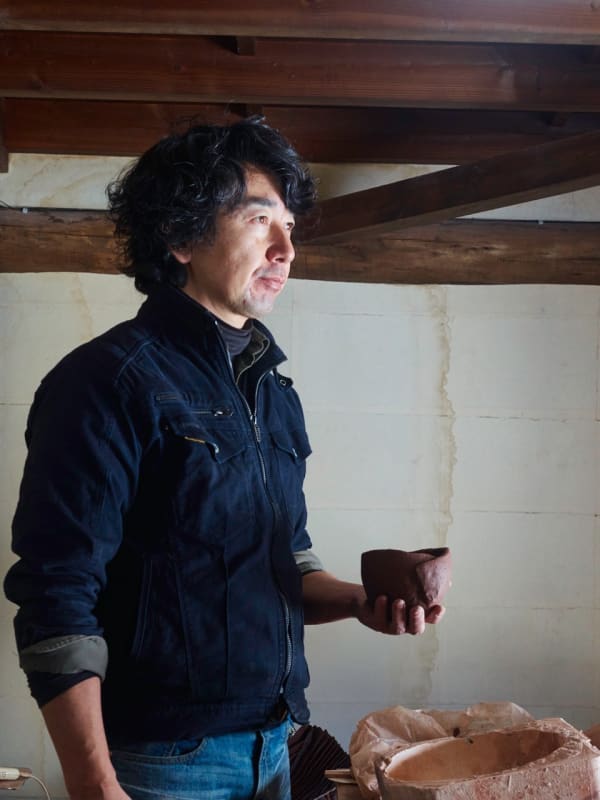 Events
EventsOpening Reception - Thursday, January 13
Layers of Time: Spatial Ceramic Works by Yukiya Izumita 13 Jan 2022NEW YORK - Ippodo Gallery welcomes you to Layers of Time: Spatial Ceramic Works by Yukiya Izumita. The 25 ceramic works in the Yukiya Izumita...Read more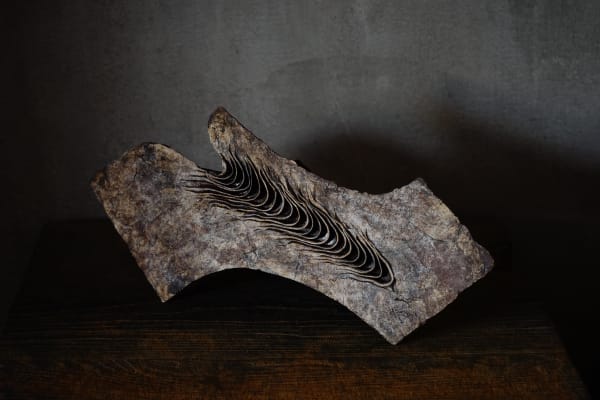 Videos
VideosBehind the Scenes
Layers of Time: Spatial Works by Yukiya IzumitaJan 5, 2022Izumita relies on the salt-rich clay of the Iwate prefecture in the Tohuku region of Northeast Japan, known for its harsh weather. Watch Izumita inventively...Read more
Related artist
This website uses cookies
This site uses cookies to help make it more useful to you. Please contact us to find out more about our Cookie Policy.
Join the Ippodo Gallery newsletter
* denotes required fields
We will process the personal data you have supplied to communicate with you in accordance with our Privacy Policy. You can unsubscribe or change your preferences at any time by clicking the link in our emails.








